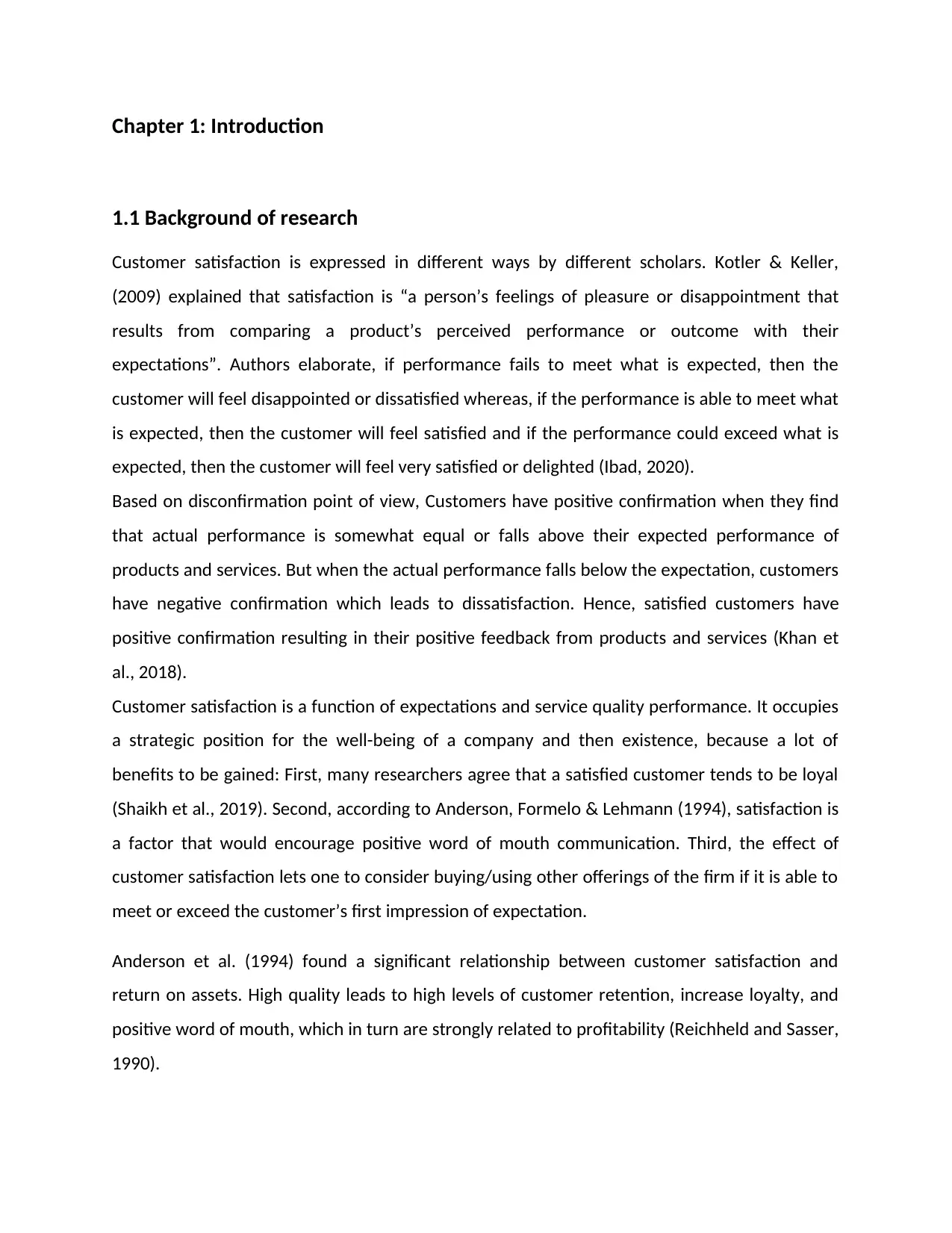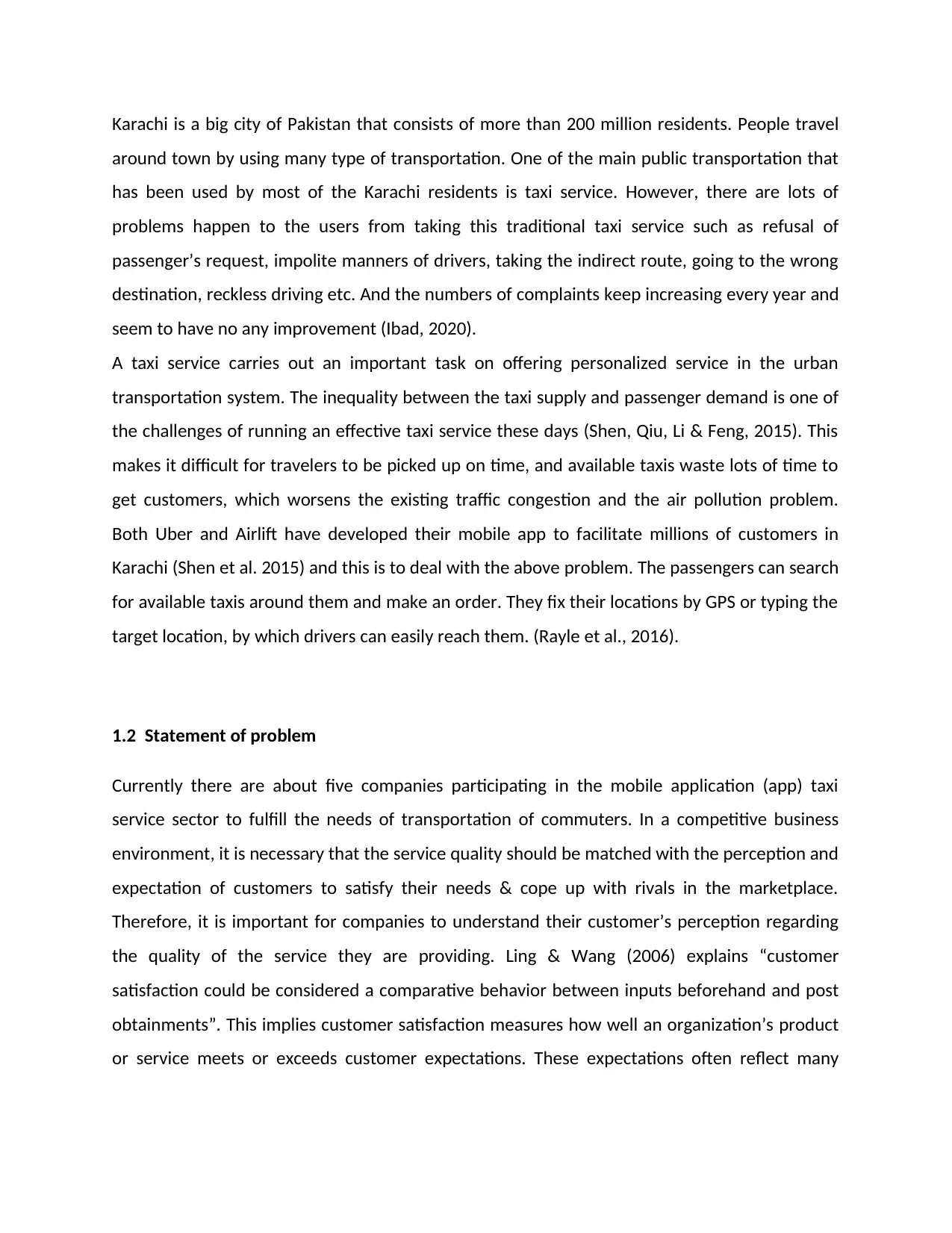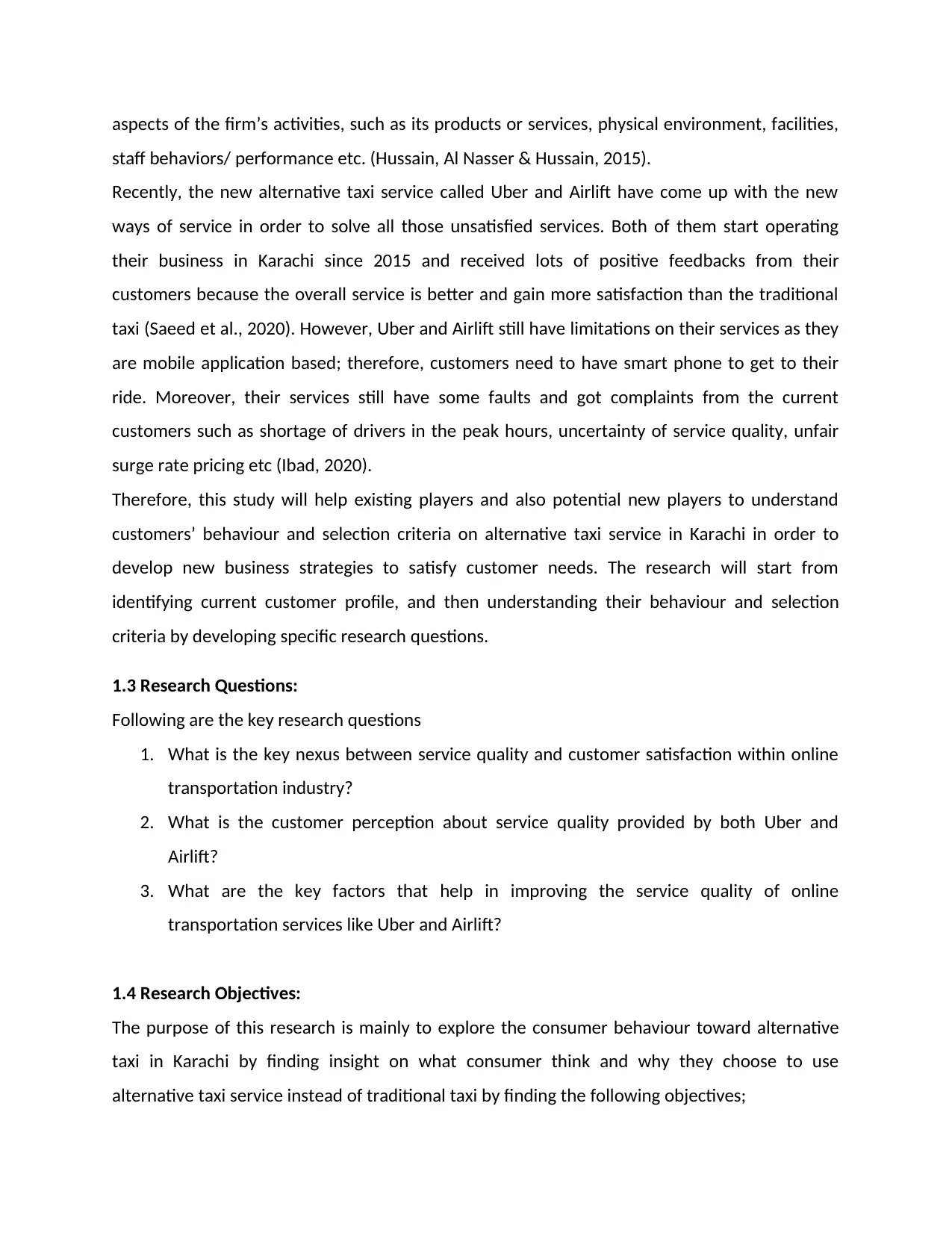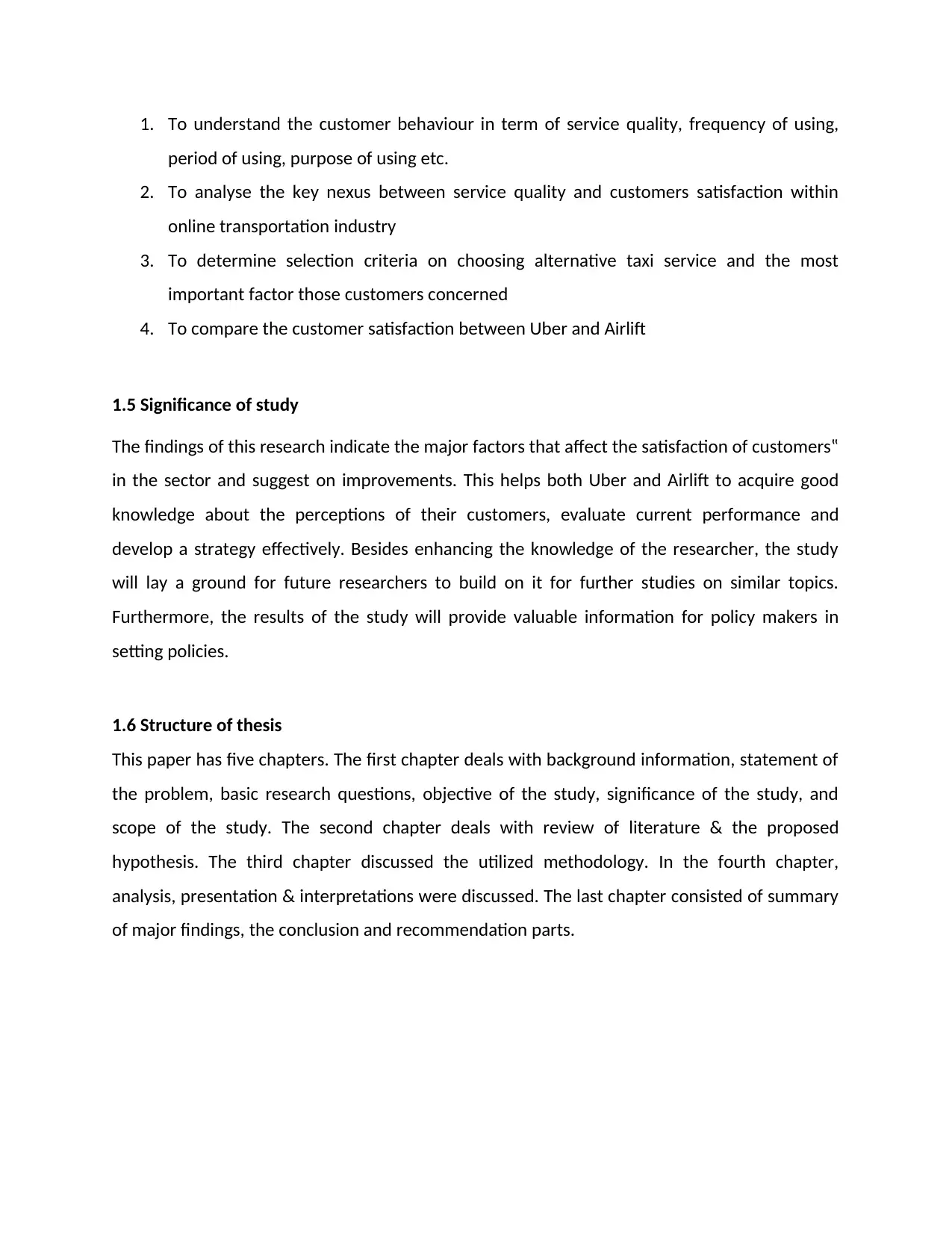Customer Perception: Uber and Airlift in Karachi Taxi Services
VerifiedAdded on 2021/05/29
|4
|1390
|396
Report
AI Summary
This report investigates customer satisfaction within the taxi service sector in Karachi, Pakistan, with a specific focus on the emerging mobile application-based services like Uber and Airlift. The research begins by establishing the background of the problem, highlighting the prevalent issues with traditional taxi services and the rise of app-based alternatives. The study formulates research questions to explore the nexus between service quality and customer satisfaction, customer perceptions of Uber and Airlift, and factors for improving service quality. Objectives include understanding customer behavior, analyzing the relationship between service quality and satisfaction, identifying selection criteria, and comparing customer satisfaction between Uber and Airlift. The significance of the study lies in its potential to provide insights for service providers, policymakers, and future researchers. The report is structured into five chapters, covering introduction, literature review, methodology, analysis, and conclusions.

Chapter 1: Introduction
1.1 Background of research
Customer satisfaction is expressed in different ways by different scholars. Kotler & Keller,
(2009) explained that satisfaction is “a person’s feelings of pleasure or disappointment that
results from comparing a product’s perceived performance or outcome with their
expectations”. Authors elaborate, if performance fails to meet what is expected, then the
customer will feel disappointed or dissatisfied whereas, if the performance is able to meet what
is expected, then the customer will feel satisfied and if the performance could exceed what is
expected, then the customer will feel very satisfied or delighted (Ibad, 2020).
Based on disconfirmation point of view, Customers have positive confirmation when they find
that actual performance is somewhat equal or falls above their expected performance of
products and services. But when the actual performance falls below the expectation, customers
have negative confirmation which leads to dissatisfaction. Hence, satisfied customers have
positive confirmation resulting in their positive feedback from products and services (Khan et
al., 2018).
Customer satisfaction is a function of expectations and service quality performance. It occupies
a strategic position for the well-being of a company and then existence, because a lot of
benefits to be gained: First, many researchers agree that a satisfied customer tends to be loyal
(Shaikh et al., 2019). Second, according to Anderson, Formelo & Lehmann (1994), satisfaction is
a factor that would encourage positive word of mouth communication. Third, the effect of
customer satisfaction lets one to consider buying/using other offerings of the firm if it is able to
meet or exceed the customer’s first impression of expectation.
Anderson et al. (1994) found a significant relationship between customer satisfaction and
return on assets. High quality leads to high levels of customer retention, increase loyalty, and
positive word of mouth, which in turn are strongly related to profitability (Reichheld and Sasser,
1990).
1.1 Background of research
Customer satisfaction is expressed in different ways by different scholars. Kotler & Keller,
(2009) explained that satisfaction is “a person’s feelings of pleasure or disappointment that
results from comparing a product’s perceived performance or outcome with their
expectations”. Authors elaborate, if performance fails to meet what is expected, then the
customer will feel disappointed or dissatisfied whereas, if the performance is able to meet what
is expected, then the customer will feel satisfied and if the performance could exceed what is
expected, then the customer will feel very satisfied or delighted (Ibad, 2020).
Based on disconfirmation point of view, Customers have positive confirmation when they find
that actual performance is somewhat equal or falls above their expected performance of
products and services. But when the actual performance falls below the expectation, customers
have negative confirmation which leads to dissatisfaction. Hence, satisfied customers have
positive confirmation resulting in their positive feedback from products and services (Khan et
al., 2018).
Customer satisfaction is a function of expectations and service quality performance. It occupies
a strategic position for the well-being of a company and then existence, because a lot of
benefits to be gained: First, many researchers agree that a satisfied customer tends to be loyal
(Shaikh et al., 2019). Second, according to Anderson, Formelo & Lehmann (1994), satisfaction is
a factor that would encourage positive word of mouth communication. Third, the effect of
customer satisfaction lets one to consider buying/using other offerings of the firm if it is able to
meet or exceed the customer’s first impression of expectation.
Anderson et al. (1994) found a significant relationship between customer satisfaction and
return on assets. High quality leads to high levels of customer retention, increase loyalty, and
positive word of mouth, which in turn are strongly related to profitability (Reichheld and Sasser,
1990).
Paraphrase This Document
Need a fresh take? Get an instant paraphrase of this document with our AI Paraphraser

Karachi is a big city of Pakistan that consists of more than 200 million residents. People travel
around town by using many type of transportation. One of the main public transportation that
has been used by most of the Karachi residents is taxi service. However, there are lots of
problems happen to the users from taking this traditional taxi service such as refusal of
passenger’s request, impolite manners of drivers, taking the indirect route, going to the wrong
destination, reckless driving etc. And the numbers of complaints keep increasing every year and
seem to have no any improvement (Ibad, 2020).
A taxi service carries out an important task on offering personalized service in the urban
transportation system. The inequality between the taxi supply and passenger demand is one of
the challenges of running an effective taxi service these days (Shen, Qiu, Li & Feng, 2015). This
makes it difficult for travelers to be picked up on time, and available taxis waste lots of time to
get customers, which worsens the existing traffic congestion and the air pollution problem.
Both Uber and Airlift have developed their mobile app to facilitate millions of customers in
Karachi (Shen et al. 2015) and this is to deal with the above problem. The passengers can search
for available taxis around them and make an order. They fix their locations by GPS or typing the
target location, by which drivers can easily reach them. (Rayle et al., 2016).
1.2 Statement of problem
Currently there are about five companies participating in the mobile application (app) taxi
service sector to fulfill the needs of transportation of commuters. In a competitive business
environment, it is necessary that the service quality should be matched with the perception and
expectation of customers to satisfy their needs & cope up with rivals in the marketplace.
Therefore, it is important for companies to understand their customer’s perception regarding
the quality of the service they are providing. Ling & Wang (2006) explains “customer
satisfaction could be considered a comparative behavior between inputs beforehand and post
obtainments”. This implies customer satisfaction measures how well an organization’s product
or service meets or exceeds customer expectations. These expectations often reflect many
around town by using many type of transportation. One of the main public transportation that
has been used by most of the Karachi residents is taxi service. However, there are lots of
problems happen to the users from taking this traditional taxi service such as refusal of
passenger’s request, impolite manners of drivers, taking the indirect route, going to the wrong
destination, reckless driving etc. And the numbers of complaints keep increasing every year and
seem to have no any improvement (Ibad, 2020).
A taxi service carries out an important task on offering personalized service in the urban
transportation system. The inequality between the taxi supply and passenger demand is one of
the challenges of running an effective taxi service these days (Shen, Qiu, Li & Feng, 2015). This
makes it difficult for travelers to be picked up on time, and available taxis waste lots of time to
get customers, which worsens the existing traffic congestion and the air pollution problem.
Both Uber and Airlift have developed their mobile app to facilitate millions of customers in
Karachi (Shen et al. 2015) and this is to deal with the above problem. The passengers can search
for available taxis around them and make an order. They fix their locations by GPS or typing the
target location, by which drivers can easily reach them. (Rayle et al., 2016).
1.2 Statement of problem
Currently there are about five companies participating in the mobile application (app) taxi
service sector to fulfill the needs of transportation of commuters. In a competitive business
environment, it is necessary that the service quality should be matched with the perception and
expectation of customers to satisfy their needs & cope up with rivals in the marketplace.
Therefore, it is important for companies to understand their customer’s perception regarding
the quality of the service they are providing. Ling & Wang (2006) explains “customer
satisfaction could be considered a comparative behavior between inputs beforehand and post
obtainments”. This implies customer satisfaction measures how well an organization’s product
or service meets or exceeds customer expectations. These expectations often reflect many

aspects of the firm’s activities, such as its products or services, physical environment, facilities,
staff behaviors/ performance etc. (Hussain, Al Nasser & Hussain, 2015).
Recently, the new alternative taxi service called Uber and Airlift have come up with the new
ways of service in order to solve all those unsatisfied services. Both of them start operating
their business in Karachi since 2015 and received lots of positive feedbacks from their
customers because the overall service is better and gain more satisfaction than the traditional
taxi (Saeed et al., 2020). However, Uber and Airlift still have limitations on their services as they
are mobile application based; therefore, customers need to have smart phone to get to their
ride. Moreover, their services still have some faults and got complaints from the current
customers such as shortage of drivers in the peak hours, uncertainty of service quality, unfair
surge rate pricing etc (Ibad, 2020).
Therefore, this study will help existing players and also potential new players to understand
customers’ behaviour and selection criteria on alternative taxi service in Karachi in order to
develop new business strategies to satisfy customer needs. The research will start from
identifying current customer profile, and then understanding their behaviour and selection
criteria by developing specific research questions.
1.3 Research Questions:
Following are the key research questions
1. What is the key nexus between service quality and customer satisfaction within online
transportation industry?
2. What is the customer perception about service quality provided by both Uber and
Airlift?
3. What are the key factors that help in improving the service quality of online
transportation services like Uber and Airlift?
1.4 Research Objectives:
The purpose of this research is mainly to explore the consumer behaviour toward alternative
taxi in Karachi by finding insight on what consumer think and why they choose to use
alternative taxi service instead of traditional taxi by finding the following objectives;
staff behaviors/ performance etc. (Hussain, Al Nasser & Hussain, 2015).
Recently, the new alternative taxi service called Uber and Airlift have come up with the new
ways of service in order to solve all those unsatisfied services. Both of them start operating
their business in Karachi since 2015 and received lots of positive feedbacks from their
customers because the overall service is better and gain more satisfaction than the traditional
taxi (Saeed et al., 2020). However, Uber and Airlift still have limitations on their services as they
are mobile application based; therefore, customers need to have smart phone to get to their
ride. Moreover, their services still have some faults and got complaints from the current
customers such as shortage of drivers in the peak hours, uncertainty of service quality, unfair
surge rate pricing etc (Ibad, 2020).
Therefore, this study will help existing players and also potential new players to understand
customers’ behaviour and selection criteria on alternative taxi service in Karachi in order to
develop new business strategies to satisfy customer needs. The research will start from
identifying current customer profile, and then understanding their behaviour and selection
criteria by developing specific research questions.
1.3 Research Questions:
Following are the key research questions
1. What is the key nexus between service quality and customer satisfaction within online
transportation industry?
2. What is the customer perception about service quality provided by both Uber and
Airlift?
3. What are the key factors that help in improving the service quality of online
transportation services like Uber and Airlift?
1.4 Research Objectives:
The purpose of this research is mainly to explore the consumer behaviour toward alternative
taxi in Karachi by finding insight on what consumer think and why they choose to use
alternative taxi service instead of traditional taxi by finding the following objectives;
⊘ This is a preview!⊘
Do you want full access?
Subscribe today to unlock all pages.

Trusted by 1+ million students worldwide

1. To understand the customer behaviour in term of service quality, frequency of using,
period of using, purpose of using etc.
2. To analyse the key nexus between service quality and customers satisfaction within
online transportation industry
3. To determine selection criteria on choosing alternative taxi service and the most
important factor those customers concerned
4. To compare the customer satisfaction between Uber and Airlift
1.5 Significance of study
The findings of this research indicate the major factors that affect the satisfaction of customers‟
in the sector and suggest on improvements. This helps both Uber and Airlift to acquire good
knowledge about the perceptions of their customers, evaluate current performance and
develop a strategy effectively. Besides enhancing the knowledge of the researcher, the study
will lay a ground for future researchers to build on it for further studies on similar topics.
Furthermore, the results of the study will provide valuable information for policy makers in
setting policies.
1.6 Structure of thesis
This paper has five chapters. The first chapter deals with background information, statement of
the problem, basic research questions, objective of the study, significance of the study, and
scope of the study. The second chapter deals with review of literature & the proposed
hypothesis. The third chapter discussed the utilized methodology. In the fourth chapter,
analysis, presentation & interpretations were discussed. The last chapter consisted of summary
of major findings, the conclusion and recommendation parts.
period of using, purpose of using etc.
2. To analyse the key nexus between service quality and customers satisfaction within
online transportation industry
3. To determine selection criteria on choosing alternative taxi service and the most
important factor those customers concerned
4. To compare the customer satisfaction between Uber and Airlift
1.5 Significance of study
The findings of this research indicate the major factors that affect the satisfaction of customers‟
in the sector and suggest on improvements. This helps both Uber and Airlift to acquire good
knowledge about the perceptions of their customers, evaluate current performance and
develop a strategy effectively. Besides enhancing the knowledge of the researcher, the study
will lay a ground for future researchers to build on it for further studies on similar topics.
Furthermore, the results of the study will provide valuable information for policy makers in
setting policies.
1.6 Structure of thesis
This paper has five chapters. The first chapter deals with background information, statement of
the problem, basic research questions, objective of the study, significance of the study, and
scope of the study. The second chapter deals with review of literature & the proposed
hypothesis. The third chapter discussed the utilized methodology. In the fourth chapter,
analysis, presentation & interpretations were discussed. The last chapter consisted of summary
of major findings, the conclusion and recommendation parts.
1 out of 4
Your All-in-One AI-Powered Toolkit for Academic Success.
+13062052269
info@desklib.com
Available 24*7 on WhatsApp / Email
![[object Object]](/_next/static/media/star-bottom.7253800d.svg)
Unlock your academic potential
Copyright © 2020–2025 A2Z Services. All Rights Reserved. Developed and managed by ZUCOL.

